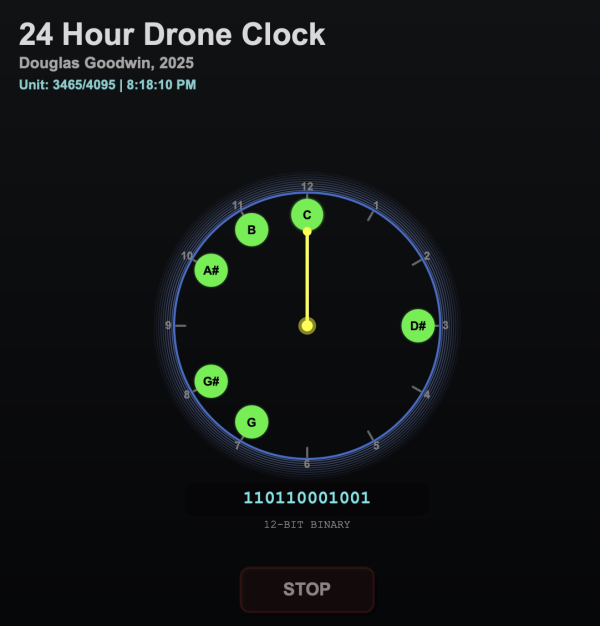Spectral Sound clock
Temporal Music: Sonifying Time Through Binary Encoding and Non-Tonal Scales
This project explores the intersection of time, binary mathematics, and algorithmic music by creating a musical clock that translates the passage of time into evolving harmonic drones.
Inspiration
The concept emerged from student presentations in my CalArts Unconventional Computing course, where students discussed clock faces and 12-tone non-tonal scales. Working from what may have been my own creative misunderstanding of their ideas, combined with teenage piano lessons exploring chromatic relationships, I became fascinated with the possibility of actually playing time itself.
Concept
The system maps three corresponding 12-unit structures:
- 12 clock positions (traditional time representation)
- 12 chromatic tones (complete musical pitch space)
- 12 binary digits (computational representation)
Implementation
The 24-hour day is divided into 4,096 equal units (~21 seconds each). Each unit number converts to 12-bit binary, with each bit position mapped to a chromatic tone (C through B). A visual "seconds hand" sweeps around a clock face, evaluating one note position every 1.7 seconds throughout each period. Notes turn on when their corresponding binary bit is 1, creating a continuously evolving harmonic drone.
Musical Evolution
This creates fascinating patterns throughout the day:
Midnight (Unit 0): Binary 000000000000 → Silence
Early Morning: Sparse harmonies with few active tones
Late Evening: Complex dense chords approaching 12-tone clusters
Day's End (Unit 4095): Binary 111111111111 → Complete chromatic drone
The binary structure creates predictable yet surprising musical evolution, with the most frequent changes occurring at the "12 o'clock" position (rightmost bit), creating natural visual focus.
Philosophy
This project reframes time itself as compositional material, where temporal progression becomes the algorithmic basis for musical creation. Unlike traditional generative music using randomness, this temporal music is entirely deterministic yet continuously novel—each moment of each day has its own unique harmonic signature.
The work demonstrates how creative misunderstandings can lead to genuine innovation, and how familiar data (time) can be made experientially accessible through alternative sensory modalities.
Inspired by student discussions in Unconventional Computing, though the specific implementation represents my own interpretation and development of those ideas.
